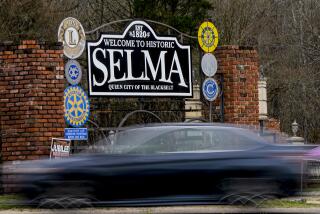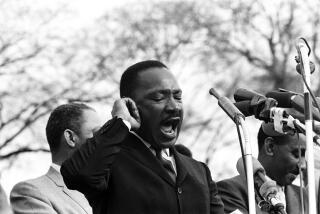Opinion: What the Los Angeles Times said about Selma 50 years ago
The thick-lettered headline on the front page of the Los Angeles Times 50 years ago today was terse and unambiguous: “Negro Marchers Clubbed” and then, in larger type, “Melee in Selma,” over a five-column photo of a white trooper bludgeoning a downed black marcher at the Edmund Pettus Bridge.
The paper published two main stories from Selma, Ala., that morning about what became known as Bloody Sunday. One article by United Press International began, “State troopers and mounted deputies bombarded 600 Negroes with tear gas Sunday when they knelt to pray on a bridge, then attacked them with clubs.” The second story, by Times staff writer Jack Nelson, captured the protesters’ resolve, and the tension that would transform the small Southern city into an international symbol of African Americans’ struggle to exercise their right to vote.
“Negroes in a mass meeting here Sunday night shouted defiance of Gov. George C. Wallace and his club-waving troops and declared they will march again Tuesday,” Nelson wrote. He went on to describe the crowd’s denunciations of President Johnson over his failure to send federal marshals requested by the Rev. Martin Luther King Jr. to protect the marchers. Then he quoted King aide Andrew Young: “It’s a waste of time to call on Washington. We will do what we have to do and let Washington do what they have to do.”
The civil rights activists organized two more marches, each an attempt to make the symbolic trek from Selma to the state capital in Montgomery, 54 miles away. The first effort on March 9, two days after Bloody Sunday, turned into a protest prayer session at the bridge when organizers decided not to defy a federal judge’s temporary injunction against marching. Two weeks after Bloody Sunday, the injunction lifted and with federal troops finally in place as protectors, the third march began. It ended four days later with a rally of 25,000 people at the state Capitol, a symbolic success that was undercut later that night by the murder of Viola Liuzzo, a white Detroit mother of five who had left her family to help with the struggle.
There is a lot of room for debate over how much life for African Americans has changed in the half-century since Selma. There may be an African American in the White House, but the racist undertones of a lot of the criticism of his administration have been depressing. Laws bar discrimination but voting rights protections have been eroded, and are under attack in some states. Wide differences in economic achievement evidence how far removed we are from true equality. And the actions of police in Ferguson, Mo., as detailed in the recent federal report, sound more like Selma in the ‘60s than what we expect from our police departments today.
So the struggle continues. Here is the Los Angeles Times editorial page’s take on the violence, which ran March 9, 1965, under the headline, “Shocking Spectacle in Selma, Ala.”
“With shocking and wholly unnecessary brutality, state troopers in Selma, Ala., last Sunday rode roughshod over 600 Negroes who had assembled peacefully to demonstrate in behalf of their long-denied constitutional right to vote.
“The ‘walk for freedom’ from Selma to Montgomery was quite frankly intended to dramatize the continuing voter registration problems faced by Negroes in most of the deep South. Despite the 15th Amendment – which has been law for 95 years – and the 1964 Civil Rights Act, Negroes still face a variety of illegal roadblocks aimed at preventing their use of the ballot.
“In some cases physical or economic coercion is employed against those who attempt to register to vote. In other cases, cynically-applied ruses are brought into play. The end result is the same. The laws of the United States, and the rights of millions of its citizens, are flouted.
“There should be no mistake about what is taking place. The white officials in black belt areas where Negroes have thus far been unable to vote know they are fighting first of all for their own political lives. Once Negroes are able to vote freely the politics of these areas will change.
“Whatever special rationalizations to the contrary may be offered, this is what the fight is about.
“Nor should there be any mistaking the motives behind Sunday’s Negro march. It was not meant to sway opinion in Selma, or Alabama, or elsewhere in the deep South. Its true purpose was to dramatize a cause and a plight, to rally national and congressional support for legislation aimed at federal guarantees for voter rights.
“The Johnson administration has promised legislation to insure voting rights, but where is it? Obviously the president fears that the inevitable southern filibuster against such legislation would jeopardize other of his programs. He faces an uncomfortable political choice.
“The push for voting rights guarantees has thus far come mainly from House Republicans, some of whom favor a system of federal registrars to oversee and even void elections in areas where discrimination exists.
“Such legislation would be an extreme step, not to be taken lightly. But what happened in Selma, Ala., on Sunday was also extreme, to the point where it sickened and aroused decent people everywhere.”
Follow Scott Martelle on Twitter @smartelle.
More to Read
A cure for the common opinion
Get thought-provoking perspectives with our weekly newsletter.
You may occasionally receive promotional content from the Los Angeles Times.







